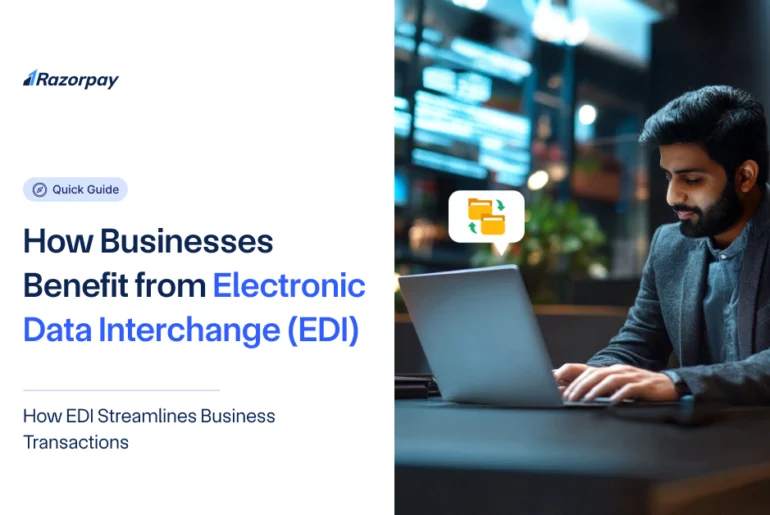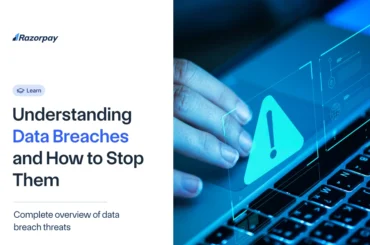Table of Contents
What is Electronic Data Interchange (EDI)?
Electronic Data Interchange (EDI) is the computer-to-computer exchange of business documents in a standardised electronic format between trading partners. EDI replaces traditional paper-based or manual document exchange, enabling businesses to send invoices, purchase orders, and shipping details automatically.
With EDI, companies can exchange critical business documents like purchase orders, invoices, and shipping notices electronically, without the need for manual intervention. This streamlines processes, reduces errors, and speeds up the flow of information between trading partners.
Benefits of Electronic Data Interchange
Implementing EDI offers numerous advantages that streamline everyday business processes and improve overall operational efficiency. Let’s explore the key benefits:
1. Saves Time
By eliminating manual data entry and document handling, EDI significantly reduces processing times. Documents that took days to arrive via post can be exchanged within minutes.
2. Reduces Errors
EDI minimises human intervention, thereby reducing errors caused by illegible handwriting, lost paperwork, or inaccurate data entry. This leads to improved data quality and fewer costly mistakes.
3. Improves Security
EDI transactions occur over secure networks with built-in encryption and authentication measures. This ensures that sensitive business data remains confidential and reaches only intended recipients.
4. Better Connectivity
EDI enables faster, more efficient communication between trading partners. It helps strengthen business relationships by providing a reliable, always-on channel for exchanging critical information.
Types of EDI Transactions
EDI supports various types of business transactions, each identified by a specific document number. Here are some common examples:
-
EDI 850 (Purchase Order): Used to place an order for goods or services.
-
EDI 855 (Purchase Order Acknowledgement): Confirms receipt and acceptance or rejection of a purchase order.
-
EDI 856 (Advance Ship Notice): Provides detailed information about a pending delivery, including shipment contents and expected arrival date.
-
EDI 810 (Invoice): Requests payment for goods or services provided.
-
EDI 846 (Inventory Inquiry/Advice): Used to inquire about current inventory levels or provide inventory status updates.
These transactions form the backbone of electronic data interchange in e-commerce, enabling businesses to automate key processes and exchange information efficiently.
How Does Electronic Data Interchange Work?
EDI works by establishing a direct connection between the computer systems of trading partners. There are two main methods of EDI communication:
1. Direct EDI (Point-to-Point):
In this approach, businesses establish a direct connection using secure protocols like AS2, SFTP, or HTTPS. This method is suitable for organisations with high volumes of EDI transactions and requires compatible software at both ends.
2. Value-Added Network (VAN):
A VAN acts as an intermediary between trading partners, facilitating the exchange of EDI documents. It provides additional services like document translation, secure storage, and technical support. VANs are beneficial for companies with multiple trading partners or those lacking in-house EDI expertise.
Regardless of the method chosen, the fundamental process remains the same: data is extracted, translated into a standard format, transmitted securely, and then translated back into the recipient’s system format.
What is Needed to Set Up Electronic Data Interchange?
Implementing EDI requires careful planning and preparation. Here are the key steps involved:
1. Set Up the System
Businesses need to invest in EDI software that can translate internal data into the required standard format (e.g., ANSI ASC X12 or UN/EDIFACT). This may involve purchasing a standalone solution or integrating EDI capabilities into existing enterprise resource planning (ERP) or accounting systems.
2. Connect with Partners
Establishing connectivity with trading partners is crucial for successful EDI implementation. This involves agreeing on the communication method (direct or via a VAN), determining the specific documents to exchange, and testing the connection to ensure smooth data flow.
3. Follow EDI Standards
Adhering to industry-specific EDI standards is essential for seamless communication. Businesses must ensure that their EDI software supports the required standards and that their internal systems can generate and consume data in the specified formats.
Challenges of Using Electronic Data Interchange
While EDI offers numerous benefits, businesses may face certain challenges during implementation and ongoing usage:
1. High Setup Costs
Implementing EDI requires an initial investment in software, hardware, and personnel training. Smaller businesses may find these upfront costs prohibitive, especially if they have limited IT resources or a small number of trading partners.
2. Difficult Document Mapping
Translating internal data into EDI formats can be complex, especially for businesses with unique or customised systems. This process, known as document mapping, requires technical expertise and can be time-consuming.
3. Problems with Scaling
As businesses grow and add more trading partners, managing EDI connections can become increasingly complex. Ensuring compatibility, maintaining multiple connections, and troubleshooting issues can strain IT resources.
4. Ongoing Monitoring
EDI systems require continuous monitoring to ensure data integrity and timely document exchange. Businesses must have processes in place to track transactions, resolve errors, and maintain system uptime.
Related Read: What Is Credential Stuffing?
Conclusion
Electronic Data Interchange (EDI) is a critical tool for businesses looking to streamline their operations, reduce costs, and improve collaboration with trading partners. By automating the exchange of business documents, EDI saves time, reduces errors, enhances security, and enables better connectivity across the supply chain. As e-commerce continues to grow, EDI’s role in facilitating efficient supply chain management and seamless data exchange will only become more critical.
Frequently Asked Questions (FAQs)
1. What industries use EDI?
EDI is widely used across industries such as retail, manufacturing, healthcare, automotive, and logistics for B2B document exchange.
2. What are the common EDI standards?
The most widely used EDI standards are ANSI X12 in North America and EDIFACT (Electronic Data Interchange for Administration, Commerce and Transport) globally.
3. Is EDI secure?
Yes, EDI is highly secure. Documents are exchanged over encrypted networks using secure protocols, with access restricted to authenticated parties only.
4. How much does EDI cost?
EDI costs can vary depending on factors like the chosen solution (in-house vs cloud), number of trading partners, transaction volume, and level of integration required. Typical costs include setup fees, monthly subscriptions, and per-transaction charges.
5. Can small businesses use EDI, or is it only for enterprises?
While EDI has traditionally been used by larger enterprises, affordable cloud-based EDI solutions have made it accessible to businesses of all sizes. Many small and medium-sized companies are now leveraging EDI to automate B2B transactions.
6. How long does it take to implement EDI?
The time required to implement EDI varies based on the complexity of your business processes, IT environment, and the number of trading partners involved. A typical implementation can take anywhere from a few weeks to several months.





